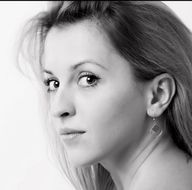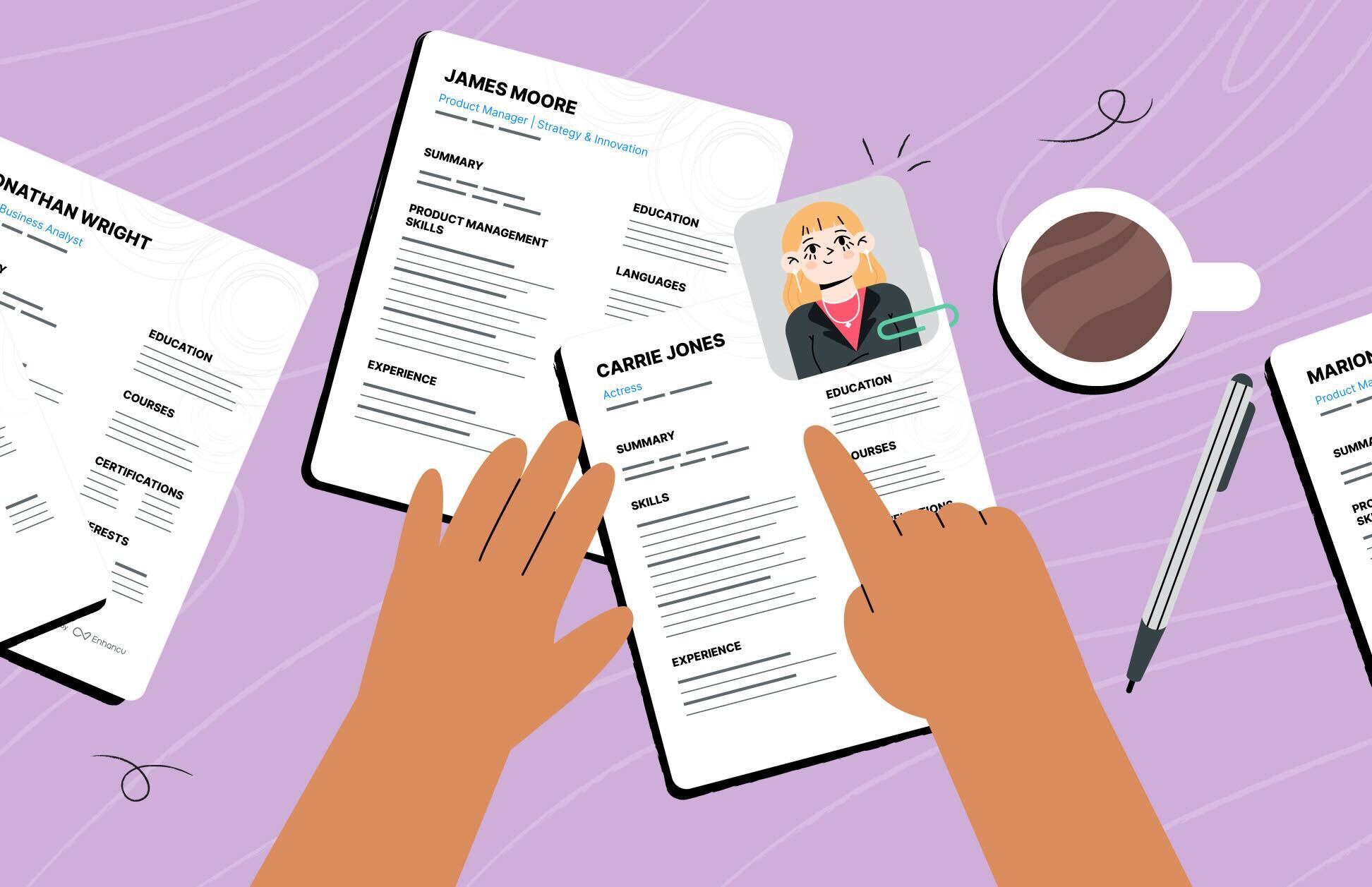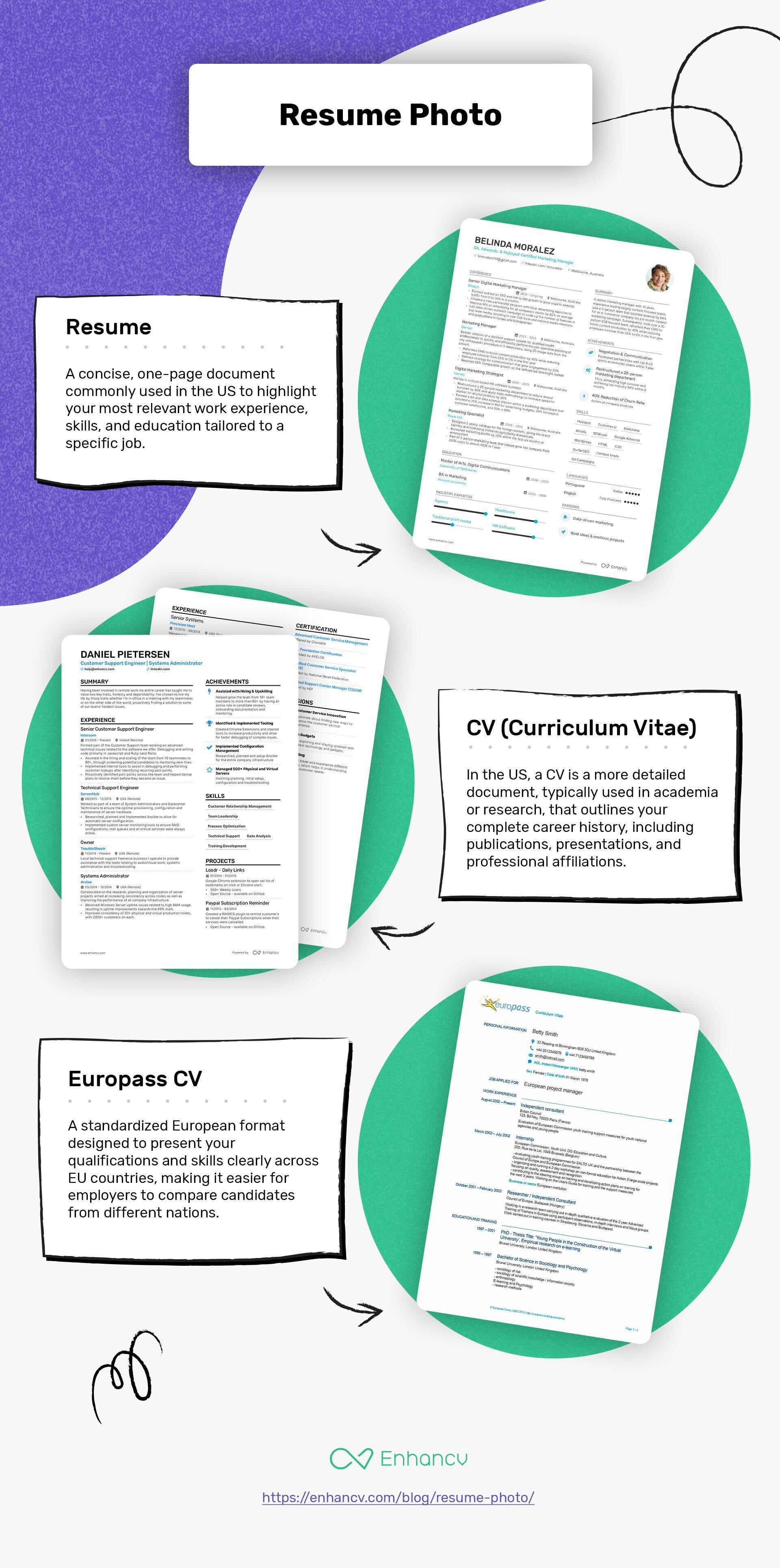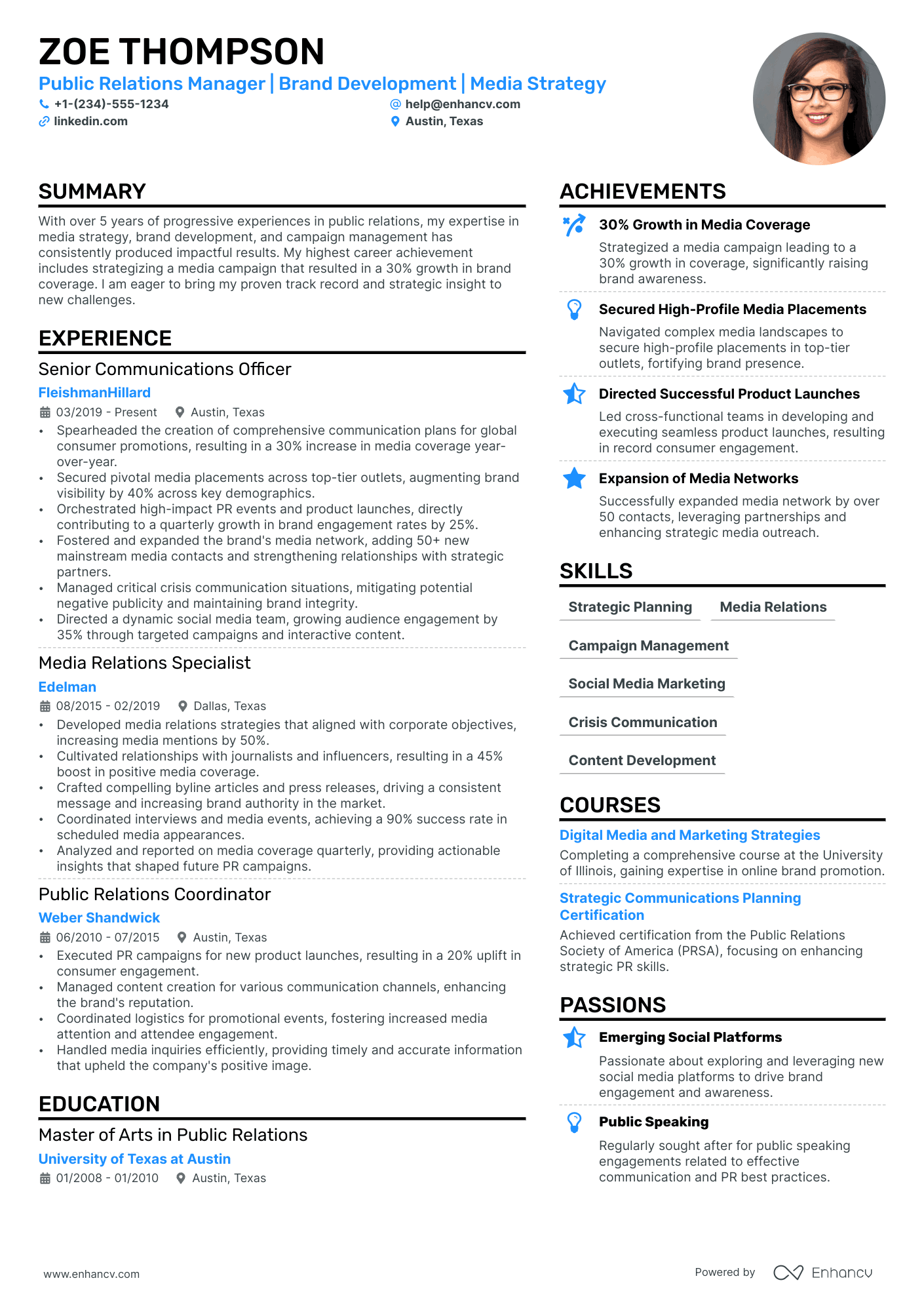It’s best not to include a photo on your resume, especially if you’re applying in the US. Experts say it can lead to bias and doesn't add value to your qualifications. However, resume photo norms vary by country and industry, so it’s worth checking local practices before deciding.
Including a photo on your resume can have a big impact on how recruiters perceive your application. In some regions, like Europe, adding a photo to your CV is almost expected and can help you stand out. However, in places like the US, Canada, and the UK, it might work against you by introducing potential bias.
Since resume photo standards vary widely across the globe, it’s crucial to know when it’s appropriate. In this guide, we’ll help you decide whether to put a photo on your resume, how to do it if you choose to, and the common pitfalls to avoid, ensuring you make the best possible impression on hiring managers.
Key takeaways
- In some regions like Europe, adding a photo to your resume is expected and can make your application stand out. In the US, Canada, and the UK, however, it might lead to bias and is often not recommended.
- Certain fields, like hospitality and entertainment, often favor including a resume photo, while more conservative industries like law and academia generally don’t.
- Including a photo might introduce unconscious bias and, in some cases, can disrupt ATS, so think carefully about whether it’s needed.
- Instead of adding a photo directly to your resume, consider linking to your LinkedIn profile or a professional portfolio to provide a visual reference without cluttering your resume.
- If you decide to add a photo, make sure it’s high-quality and professional, aligning with the standards of your industry and the specific role you're applying for.
Should you include a photo on your resume?
Before we go on, let's clarify something important. There will be a lot of talk about resume practices, and we know that our international readers may have different understandings of resumes and CVs.
Here's a quick breakdown:
Resume pictures in different countries
When it comes to adding a photo to your resume, what's common or expected can vary greatly depending on where you're applying.
Countries where resume photos are omitted
In these regions, resume images are generally frowned upon. The focus is on skills and experience, and there’s a strong emphasis on avoiding any potential bias during the hiring process.
- United States
- Canada
- United Kingdom
- Ireland
- Republic of South Africa
- Australia
- Netherlands
In low-context cultures, like those listed above, communication tends to be more direct, and the emphasis is placed on explicit information rather than on non-verbal cues or contextual factors. This translates to the job application process, where the focus is on your experience and skills, not so much on appearance or personal background. Including a photo in these contexts might distract from your core competencies, leading to misinterpretation.
Regions where resume photos are common
For Americans seeking jobs outside the US, it's important to consider adding a photo to your resume. In many countries, omitting a photo could make your application stand out in a less favorable way, as employers there see photos as part of a complete candidate profile.
- Germany
- France
- Spain
- Italy
- Japan
- Most countries in Latin America
Resume photos across industries
Whether or not you should include a photo on your resume often depends on the industry you’re targeting. In some fields, your appearance can influence how you’re perceived, making a professional photo a valuable addition to your application.
Industries that value appearance
- Hospitality
- Modeling
- Acting
- Advertising and public relations
- Sales (customer-facing roles)
- Media and entertainment
PRO TIP
For resumes in modeling and acting, it’s crucial to include the right type of photos. Typically, you’ll need a high-quality headshot (usually 8x10 inches) and, for modeling, a full-length photo that shows your entire body.
When attaching these photos to your resume, avoid embedding them directly in the document, as this can affect formatting. Instead, include them as separate, clearly labeled attachments or provide a link to an online portfolio where recruiters can view your full range of photos.
Industries where photos are strongly discouraged
For conservative fields like those below, it's best to let your experience and skills do the talking and skip the photo altogether. A photo isn’t only unnecessary but can detract from your professional credentials.
- Academia
- Technology
- Healthcare
- Engineering
- Law
- Federal
- Administration
Why experts say you shouldn’t include a photo in your resume
Including a photo on your resume is generally discouraged, especially in the US, due to strict labor laws aimed at preventing discrimination.
Here’s why it’s better to leave your photo off:
- Avoiding bias and discrimination: No matter how professional they are, HR specialists are still human and can be influenced by subconscious biases related to race, gender, age, and appearance. To ensure all candidates have an equal chance, many companies prefer to exclude personal information, including photos, from resumes.
- Social media checks: If your resume catches a recruiter’s eye, they’re likely to do a social media background check. That’s why many candidates include a LinkedIn profile link—this allows hiring managers to learn more about you while keeping the focus on your professional achievements.
- Perception of professionalism: Photos on resumes can be seen as unprofessional, suggesting you’re relying on your appearance rather than your qualifications. Unless you’re applying for a role where looks are essential, a photo adds little value and takes up space better used for showcasing your experience and skills.
- Distraction from key information: With HR professionals spending an average of just 7.4 seconds on an initial resume scan, a photo can distract them from the critical details about your qualifications and experience.
- Issues with applicant tracking systems (ATS): While most ATS software can handle resume photos without issues, it's still best to avoid including one. An image can distract from the content, and in rare cases, disrupt parsing.
PRO TIP
Photos on resumes generally don’t affect ATS scanning, but some systems can struggle with smaller details like date formats, the use of commas versus spaces between skills (commas work better), or even bullet points. To ensure your resume performs well, use Enhancv’s free ATS checker to see how it measures up against real applicant tracking systems.
Best practices for adding a photo to a resume
If you’re in an industry where a resume photo is important, be mindful of these best practices:
Do’s
- Use a high-resolution, professional-looking photo to ensure quality and make a strong first impression.
- Dress appropriately for the job role and industry to align your appearance with the position you’re applying for.
- Match your resume photo with your LinkedIn profile picture to maintain consistent personal branding across platforms.
Don’ts
- Avoid selfies and casual photos, as informal images can undermine your professionalism.
- Remove distracting elements by keeping the focus on your face, not on the background or accessories.
- Ensure your photo is appropriately sized and placed to complement your resume without overshadowing the content.
How to take a great resume photo
So, you’ve decided that adding a photo to your resume will give you that extra edge in landing your dream job. But now you’re wondering—how should it look? From the right attire to the perfect lighting, here’s how to ensure your resume photo makes a great impression.
Clothes and grooming
Start by dressing the part. Choose clothes that match the vibe of the job you’re applying for. For formal positions, go with a suit or a clean dress shirt paired with a simple jacket. Neutral colors are your best bet—they’re professional and won’t distract from your face. Make sure your hair is neat, and if you wear makeup, keep it subtle and natural.
Lighting and background
Lighting is everything in a photo. Aim for natural, soft lighting to avoid harsh shadows or overly bright spots. Position yourself facing a window or use a well-lit room. The background should be neutral and quiet—a plain wall works perfectly. This way, the focus stays on you, not on what’s behind you.
Expression and posture
When it comes to your expression, keep it simple. A neutral facial expression or a gentle smile works best. You want to appear approachable and professional, so avoid overly dramatic expressions. Sit or stand up straight with a relaxed posture. Confidence is key, but you don’t want to look stiff.
Resolution and format
Your photo should be high-resolution—at least 300 dpi—to ensure it looks sharp and professional both on screen and in print. Stick to common formats like JPEG or PNG for easy uploading and compatibility. The best resume picture size is 2-by-2 inches; it’s large enough to make an impact but small enough to keep the focus on your resume content.
Editing and enhancements
After you’ve taken your photo, a little editing can go a long way. Adjust the brightness and contrast to make sure the image is clear and well-lit. But be careful not to overdo it—you want to look like yourself, not a heavily edited version.
Resume photos with AI
AI-generated resume photos can be a convenient solution if you don't have access to professional photography. For example, tools like Headshot Pro allow you to create a polished headshot from your selfies by enhancing your appearance with natural lighting, background adjustments, and retouching.
While it's generally acceptable to use these AI tools, it's crucial that the final portrait looks natural and professional, not overly stylized or unrealistic. Make sure the photo aligns with the job you're applying for and accurately reflects your true self in a way that’s appropriate for your industry.
How to add a photo to your resume
Before we dive into the different processes for adding a photo to your resume, here's a shortcut: if you choose any of our resume templates with a photo option, you can easily upload and position your image with just a few clicks, saving you time and hassle.
Now, let's explore the detailed steps for using resume builders and manually inserting photos in Word or PDF formats.
Using resume builders: adding a photo with Enhancv
- Begin by choosing a resume template from our wide range of layouts, all designed to accommodate a headshot. Click the “Start with this example” button in the top right corner.
- In the resume builder, find the green upload button and click to upload your image directly from your computer. The app will automatically adjust the size and placement for a perfect fit.
- Click on the header and select the gear icon. From there, you can easily add or remove the photo and choose its shape—round or square—to match your resume’s style.
Adding a photo in traditional formats
Most Word resume templates don’t come with built-in photo options. If you’re creating your resume in Word or converting it to a PDF, inserting an image requires a bit more manual effort.
Here’s how to do it:
- Choose a layout and decide where you want your photo to appear. Typically, the top-right or top-left corner is ideal, as it keeps the focus on your contact information and headline.
- Go to the "Insert" tab and click on "Picture." Select your photo from your files. The image will appear on your document, and you can drag it to your desired position.
- Click on the photo to adjust its size. To maintain a professional appearance, ensure the image isn’t too large—about 2x2 inches is generally recommended. Use the "Picture Tools" format tab to add a border or adjust the brightness and contrast if necessary.
- To keep the layout clean, right-click on the photo and select "Text Wrapping." Choose “Square” or “Tight” to wrap the text around the photo without disrupting the flow of your resume’s content.
- Save the finished file as a PDF to preserve the formatting. Go to "File" > "Save As" and select PDF as the file type.
PRO TIP
If you’re using a resume builder like Enhancv, the platform will help maintain consistency between your photo and the overall design. In Word, be mindful of the font sizes, margins, and spacing to ensure your photo fits seamlessly into the layout.
Resume photo mistakes to avoid
Here are the most common mistakes when it comes to pictures on resumes:
Selfie angle
Wearing a hat or heavy makeup
Poor lighting or backlight
Casual or inappropriate clothing
Distracting backgrounds
Wearing sunglasses
For a great resume photo, choose a neutral background and wear formal clothes. If you have glasses, make sure they don’t block your face. Smile gently, keep a relaxed posture, and go for a portrait shot to look both professional and approachable. Like the one here:
Alternatives to including a photo
If you’d prefer not to include a photo on your resume, several effective alternatives can still showcase your professional image:
- LinkedIn profile links: Include a link to your LinkedIn profile, where a professional photo isn’t just accepted but recommended. This allows recruiters to view your photo if they choose while keeping your resume focused on your qualifications.
- Business cards and networking resumes: At job fairs or networking events, consider handing out business cards or a specialized networking resume with your photo. This provides a visual reference that helps the people you meet remember you more easily afterward.
- Portfolio links: For creative roles, link to an online portfolio that features images of your work and a professional photo of yourself. This approach highlights your creative abilities while providing a professional image without cluttering your resume.
Conclusion
Deciding whether to include a photo on your resume depends on where you’re applying and the industry you’re targeting. Always consider what’s standard practice in your field and region, and choose the option that best showcases your professionalism. When in doubt, a polished LinkedIn profile or portfolio link can often be the perfect alternative.
Make one that's truly you.













